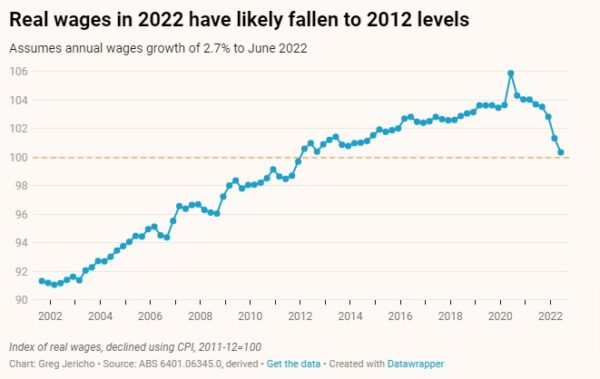The latest inflation figures from the Bureau of Statistics reveal just how much workers have been left behind. Writing in Guardian Australia, labour market and fiscal policy director Greg Jericho notes that while the focus is on the biggest annual increase in inflation since the introduction of the GST, the data also shows that real wages have fallen drastically.
Given prices grew 6.1%, but wages are expected only to achieve around 2.7% growth in the 12 months to June, it remains abundantly clear that inflation is not being driven by labour costs. Indeed given real wages have likely fallen around 3.4% in the past year, wages are currently extremely deflationary.
Real wages have now fallen for 8 consecutive quarters sending the purchasing power of employees back to 2012 levels.
While the economy has rebounded and profits have risen strongly with that of prices, the “recovery” from the pandemic has very much been on the backs of workers who have effectively lost a decade’s worth of growth in real wages.
Even worse, given the greatest price rises have occurred for essential commodities, it is clear low to median income workers are hurting much more than those who devote less of their spending on essentials than does the average household.
All this is occurring with unemployment at near 50-year lows. It is now abundantly clear that the labour market systematically disempowers employees and needs to be reformed.
Between the Lines Newsletter
The biggest stories and the best analysis from the team at the Australia Institute, delivered to your inbox every fortnight.
You might also like
Corporate Profits Must Take Hit to Save Workers
Historically high corporate profits must take a hit if workers are to claw back real wage losses from the inflationary crisis, according to new research from the Australia Institute’s Centre for Future Work.
Stronger Wage Growth improves the Economy and the Budget
Stronger wage growth will deliver more money to workers and also improve the budget position buy delivering more tax revenue
Fair Work: 5.75% Award Wage Boost will not cause “Wage-Price Spiral”
Today’s 5.75% award wage increase is a necessary boost for the lowest paid workers but does not keep pace with inflation. The Fair Work Commission (FWC) has today explicitly said this increase “will consequently not cause or contribute to any ‘wage price spiral’”. Key Points: Award wage increase of 5.75% is less than inflation, which


